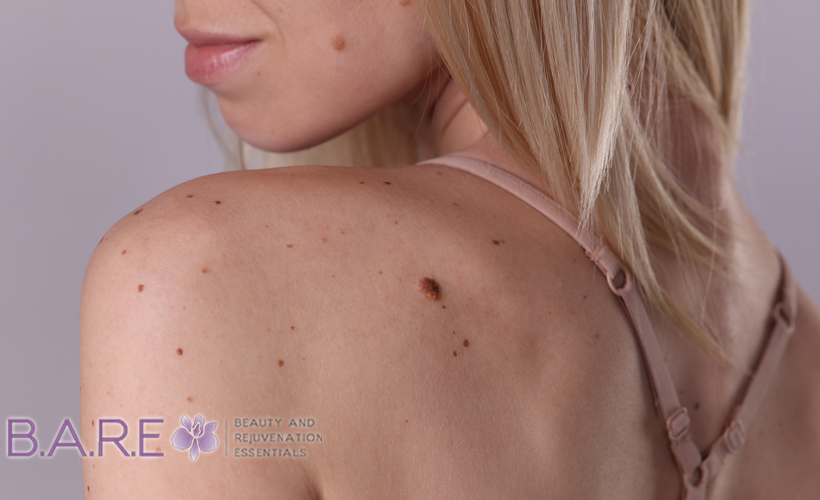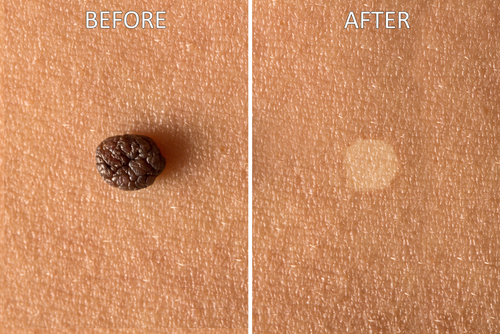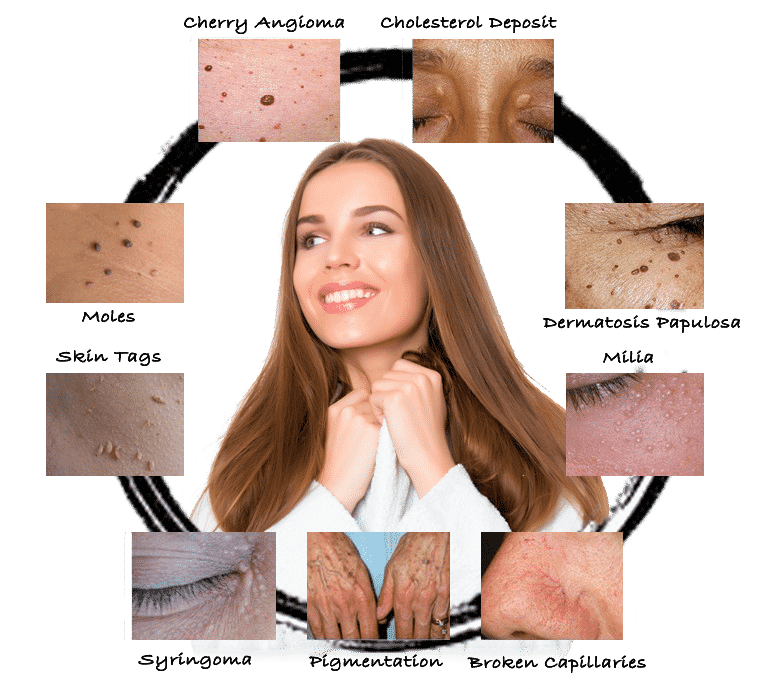
Everyone wants smooth skin, right? That’s why skin tags can be really annoying. These unnecessary growths on the skin not only look strange but are also weird to touch. They usually just sit on the skin, harmless and negligible, tempting you to pick them off. But what is the best method of skin tag removal? Is high frequency ultrasonic technology used in Perfect Skin Touch effective? Let’s find out!
What are skin tags?
A skin tag is a little outgrowth that remains attached to the surface of the skin by a tiny, thin stalk. These are painless and non-cancerous. They also don’t cause any irritation unless you scratch them. A skin tag is usually made of ducts and fibers within fat and nerve cells, covered by the epidermis.
They appear in different parts of the body where there are skin folds, like armpits, groin, upper chest, and under the breasts, and even on eyelids. If you have papilloma colli, they can also appear on the neck.
But what causes skin tags?
It’s not clear what leads to the development of skin tags. All we know is that collagen and blood vessels form clusters and get trapped inside thick bits of skin. They usually appear in the creased areas where the skin gets rubbed constantly. Some people inherit the tendency to develop skin tags.
Both men and women can develop these benign tumors, especially after the age of 50. They are common in people with diabetes or obesity. Pregnant people often develop skin tags, too. Studies also associate it with human papillomavirus and hyperinsulinemia.
Can I pick off skin tags?
Even though skin tags just sit there, making no trouble at all, nobody likes them. In fact, you might feel tempted to scratch it or just pick it off. It is recommended that you don’t pick off skin tags or cut them off, even if the tags are small and painless.
If you mess with skin tags or try to remove them carelessly, you can end up with a bad case of bleeding and infection. If either of these goes out of control, you can end up in the ER. Even if things don’t get that serious, the area of the tag can start to rot and give off the odor of rotten skin.
You can also end up with a scar. Plus, there’s always the chance of getting the tags back. There are ways to get rid of skin tags at home, especially if the tags are small. We will tell you more about how to use these methods safely later. So is it safe to remove skin tags at home?
For now, you must know that without the help of a dermatologist, removing a skin tag at home can be dangerous. It is best if you leave this to medical practitioners who know how to do it in a sanitized way after administering local anesthesia. They also know how to prevent or handle bleeding.
Are skin tags hard to touch?
Skin tags may look and feel different over time. In the initial stage, they are like small and soft bumps and match the color of your skin. Eventually, these bumps grow into tiny lumps that remain attached to the rest of the skin surface by a tiny stalk. This stalk makes it possible to wiggle the lump.
Skin tags are painless. But you should be particularly careful if you notice any change in the color of your skin tag or if it starts to hurt. You should try not to touch skin tags too often. If you end up twisting it on the stalk, you can develop a blood clot inside it. That’s what causes pain in skin tags.
What is the best way to remove skin tags?
In general, you do not need any treatment for skin tags. If they are really small, they often get rubbed off on their own. For larger moles, you can consult a doctor or esthetician. They can use the following methods to remove skin tags:
a) Cutting Off Skin Tags
Your doctor may snip off a skin tag using a pair of surgical scissors. Or, it can be removed using a scalpel. Depending on the nature of the skin tag, this minor procedure may involve simply shaving off the skin tag from the surface or cutting deeper into the skin and then putting stitches.
b) Freezing Skin Tags
For this procedure, your doctor will first apply liquid nitrogen to the skin tag. Liquid nitrogen is so cold that it will freeze the skin tag. However, because it is so cold, it will also leave a tiny burn mark on the skin in the place of the skin tag. This mark will gradually face over time, though.
c) Burning Off Skin Tags
This method calls for the application of electric current or laser beams on the upper layers of your skin to burn off the narrow stem that keeps the tump attached to the skin. The heat of high frequency ultrasonic technology will prevent bleeding. But if it does blood, the doctor will take care of it. The doctor applies an anesthetic at the beginning to minimize pain. It doesn’t usually cause scarring.
Home remedies for removing skin tags, like using nail clippers, scissors, or floss, may cause bleeding. While large skin tags should definitely be left alone to avoid severe situations, you can check with your doctor and see if moles that are smaller in size can be removed with prescribed methods and products.
There are over-the-counter mole and skin removal product kits to help you remove skin tags at home. Some kits come with a tiny band to help cut off the blood supply at the root of the stalk. The idea is that the cells will die eventually without sufficient blood supply – and fall off within 10 days.
Some kits come with creams and applicators. After sanitizing the skin, you can file down the tag and apply the cream using the applicator and allow it to absorb completely. The cream may sting a little. Eventually, the skin tags will fall off in about 2-3 weeks.
Some skin tag removal kits use cryotherapy, i.e., low temperatures. They contain liquid nitrogen that needs to be applied repeatedly on the skin tag. To prevent this liquid nitrogen from touching the other parts of the skin around the tag, apply petroleum jelly. The tags usually fall off within 10 days.
Hand-held devices for removing skin tags are also available in the market. These high-tech devices run on batteries or electricity and have multiple electric ion carbonation functions to remove skin tags. No matter what method you choose, you should always consult a health care professional first.
Skin Tag Removal with Perfect Touch
Modern skincare specialists prefer to use a non-invasive, non-surgical method of removing skin tags using laser therapy. The Perfect Touch Skin Tag Removal system by BARE Essentials uses laser technology to remove skin tags safely. This method uses a non invasive aesthetic device for instant results.
This high-tech device uses high frequency ultrasonic technology to offer quick results not only for skin tags but all kinds of common irregularities on the skin like millias, Syringoma, cholesterol or calcium deposits, etc. It is a quick and easy method to handle many types of skin blemishes.
People choose Perfect Touch Skin Tag Removal because:
- It is a non invasive. aesthetic method.
- It is fast, easy, immediate, and effective.
- It causes minimal discomfort.
- It leads to no bleeding.
- It does not cause scarring or marks.
- It is budget-friendly.
This skin tag remover can be performed on any part of the body. You can even choose it for your face. Even though there are many other methods of removing skin tags, Perfect Touch by BARE Essentials is one of the best options. You will also receive the best care from experts here.
About BARE Essentials
You can contact BARE Essentials today for an appointment to get a consultation for the best solution for mole and skin tag removal. Let us help you with our mole and skin tag removal using high frequency ultrasonic technology. For mole and skin tag removal Perfect Touch is the ultimate answer.
If you do your research to get more information about us and read customer reviews, you’ll know of the satisfaction we provide, especially when it comes to comfort and care during the mole and skin tag removal process. Be it a blemish or any other problem – we have the best treatments for all skin types to give you healthy skin. We pay attention to the application of the best practices in aesthetics.



